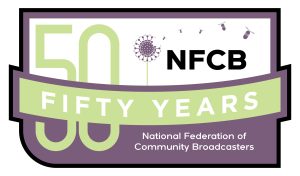
Pacifica Radio congratulates the National Federation of Community Broadcasters on their 50th anniversary this year. As a longtime champion for community radio, the NFCB has been there since 1975, with legal, technical, and programming support. The organization kicked off the celebration with their bi-annual conference in Salt Lake City in June.
As luck would have it, I was able to attend on behalf of Pacifica Network with our Network Manager Ursula Ruedenberg. We had a table alongside other vendors in the grand central room of the Marriot where everyone gathered. It was a delight to talk and connect with other radio people in person, some from right “next door” in Salt Lake City, some from many miles away, as far as Paris.
One of the organizers of the event, Sarah Mead, is a longtime colleague of community radio from KZMU, an even longer member of the non-profit sector, and a relatively recent recruit of the NFCB, as their newest Director of Member Engagement.
After a lively and heartfelt conference in Salt Lake City, Serah took some time to speak with me about what the NFCB team prioritized while planning this dedicated assembly for democracy, what matters most for community stations moving forward in a world of uncertainty, and the status of the hummus in the breakroom.
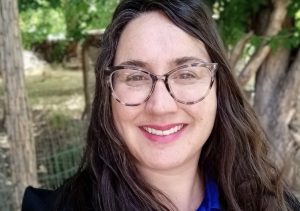
Stephanie: Congratulations on NFCB’s 50th anniversary! It was beautiful to celebrate with you at your conference in Salt Lake City.
Serah: Thank you. You know, it’s funny actually. In 2024, we were just kind of getting in the swing of having a new CEO. So all of our efforts were focused on, leadership transition and serving the membership. And then we got an email from someone who’s been involved with NFCB for a long time, and he was like, ‘Hey, just so you know, your 50th anniversary is coming up.’ It was this funny thing where we had been so deeply involved in our programming that we didn’t even realize that the 50th anniversary was that next year. So we had to go back and check the records, and be like, ‘By golly, he’s right. We are turning 50.’
Stephanie: And you are a relatively new addition to the team as the Director of Member Engagement…
Serah: Yes. My relationship with NFCB is much shorter [than other employees]. Maybe 9 or 10 years that [NFCB] has been on my radar.
Stephanie: You first became familiar with NFCB when you were with KZMU in Moab, Utah?
Serah: Yeah. I learned from my manager at the time, Marty Durlin, who has been a long time proponent of NFCB and NFCB services. So when I became the music director at the station, right away she got me connected to NFCB services. I think she saw that I was doing more at the station than what was just in my job description. You know, I was curious about grant writing and creating youth programming and things like that. So, she kind of got me connected to NFCB and made it possible for me to go attend the NFCB 2016 conference in Denver, and that totally changed my life. I think for a lot of people their first NFCB conference experience can be game changing because you meet so many people that are at stations that are similar to yours, or who are in positions that are similar to yours. And even though we celebrate the fact that being in community radio is community connection and bridge building, it can be lonely, and you’re just in your little building, and you’re like, ‘Oh no, the sink is broken again.’
Stephanie: Yes. I’m in a little office room and I talk to people over the phone, but getting to a conference where everyone speaks the same language brings about a quick kind of intimacy.
Serah: Yeah. I’m definitely kind of a big picture thinker, and I think that those kinds of experiences make a difference on a cellular level. When you’re being seen and heard, that really makes a big difference in how you operate. And absolutely, then when we go back to our stations, you’re like, ‘I’m not alone, I remember I met that station from across the country, and I’m gonna call them.’
Stephanie: Right, someone’s understanding the same thing you’re going through.
Serah: Yeah. So that first conference was pretty amazing for me. And then once I became the general manager [at KZMU], I leaned on NFCB a lot. I come from a background of nonprofits, but I hadn’t been in a leadership role yet. I had a lot of passion for and kind of intuition for radio, but there was a lot of basic information that I just didn’t know. And thankfully, NFCB was there, and Ernesto Aguilar, who was the program director at the time, was a human being who answered the phone.
[A few years later], NFCB was looking for Board positions, and I can’t remember if I nominated myself or if Marty nominated me, but somehow I was nominated as a candidate, and then I was elected by the membership, which was like, ‘holy cow,’ that felt like such an honor. And so then I served on the NFCB board for a couple of years before my board term ended, and then the former NFCB CEO Sally Kane was like, ‘You know, we got this position. I think you should apply.’
Stephanie: You seem like a good fit. It was fun to see the NFCB leaders together. You all seem like you work together well.
Serah: Oh, thanks for saying that.
Stephanie: Before we talk about the conference, I just wanted to ask– what were some of the core things that the NFCB helped you with when you were the station manager at KZMU?
Serah: I’m trying to think back on when I was really, like, ‘I need to call Ernesto,’ or ‘I need to look in the Solution Center’ or that, I mean, the listserv was Major. I got a lot [of help] from the listserv. I remember that, like, helping create a healthy and functional volunteer culture, [which] was something I was always trying to kind of tweak and fine tune, and finding the templates and the training manuals that had been uploaded into the Solution Center from other stations who volunteer, who were generous enough to say, ‘Well, here’s what we’re doing at our station.’ Those things were so useful. And I remember specifically there were a couple of stations who shared–it was almost like their program workflow, like how the departments work together and that was super helpful for me. When I was trying to communicate [to colleagues] how I’m dreaming of the station, and I’d be like, ‘Look at this. This is how it works over at, you know, this station, and they’re not us, so here’s how we would KZMU–ify this to make it work for us.’
I leaned on NFCB information when I was trying to communicate with the board about policies, procedures and like, a little bit in the funding realm. Mostly it was like, big picture station philosophy kind of stuff. And then we did a big underwriting consulting contract with Beverly James, who I learned about through the NFCB membership, and she’s amazing. So we tapped her and signed up for a multi-session consulting agreement with her that resulted in a customized kind of offering about, like, ‘Here’s what your rate sheet should look like. Here are the tools that you can use. Here’s the kind of calendar you should adopt and timeline,’ and just like to totally revamp our underwriting program. It’s funny because I can’t remember a specific thing, but when I think back about all the things I just described to you, it really hits, like, almost all the buckets of how member stations are currently reaching out to me for support; underwriting, volunteer culture, programming, and working with the board.
Stephanie: Basic building blocks.
Serah: Yes. and we had policies for legal things already in place, but I do remember using the tools on the NFCB listserv and the Solution Center and calling Ernesto about specific areas within our indecency and obscenity policy or language rules because I started to learn over time that there were certain rules that had been included that were sort of like house rules that had been adopted at a certain point and then got written down, and then kind of became like the word of law, you know. And so when a volunteer or a staff member would question me and be like, ‘Hey, why does it say this? Why is it like this here?’ And then I’d be like, ‘I don’t know.’ And I’d start looking into it and then call the NFCB, or look on the Solution Center, and be like, ‘Oh, huh. This is not actually because of the FCC. This sounds like this was something that the station adopted for purposes unknown to me. So let’s think about this. Does it still work for us?’ So then that gives you room to be flexible. But it felt like I was constantly learning, like I was constantly just behind, you know, one millimeter behind, being totally like, ‘I got this,’ you know, fine. That’s not a bad thing. That’s just, I think that’s how we all might feel.
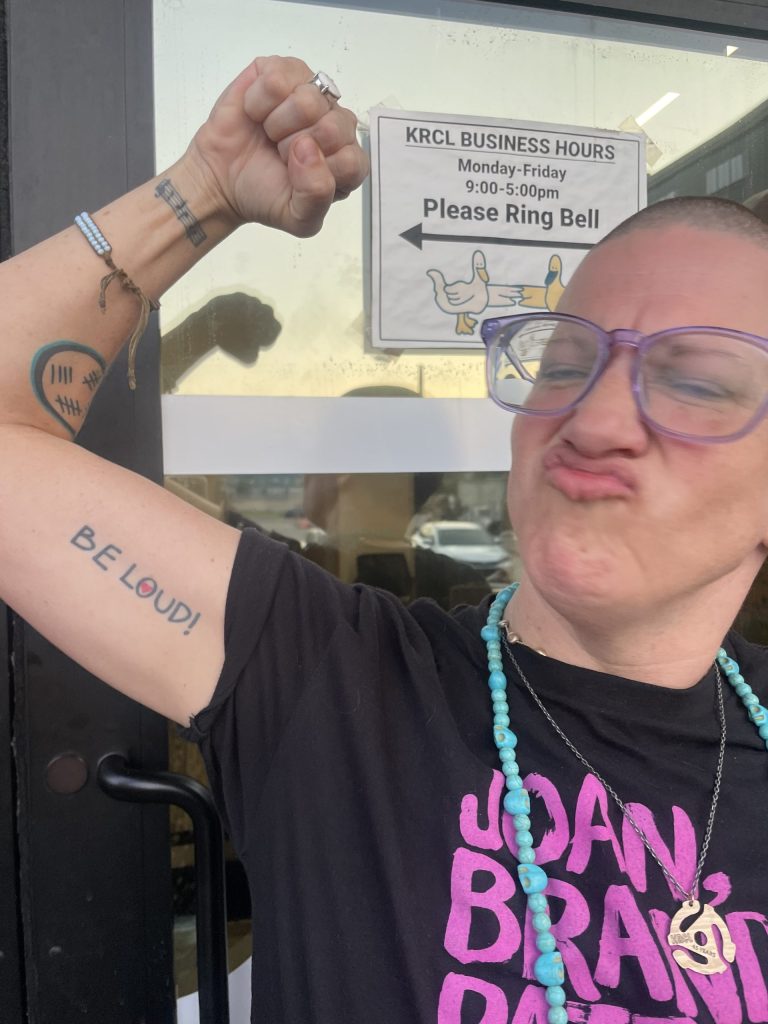
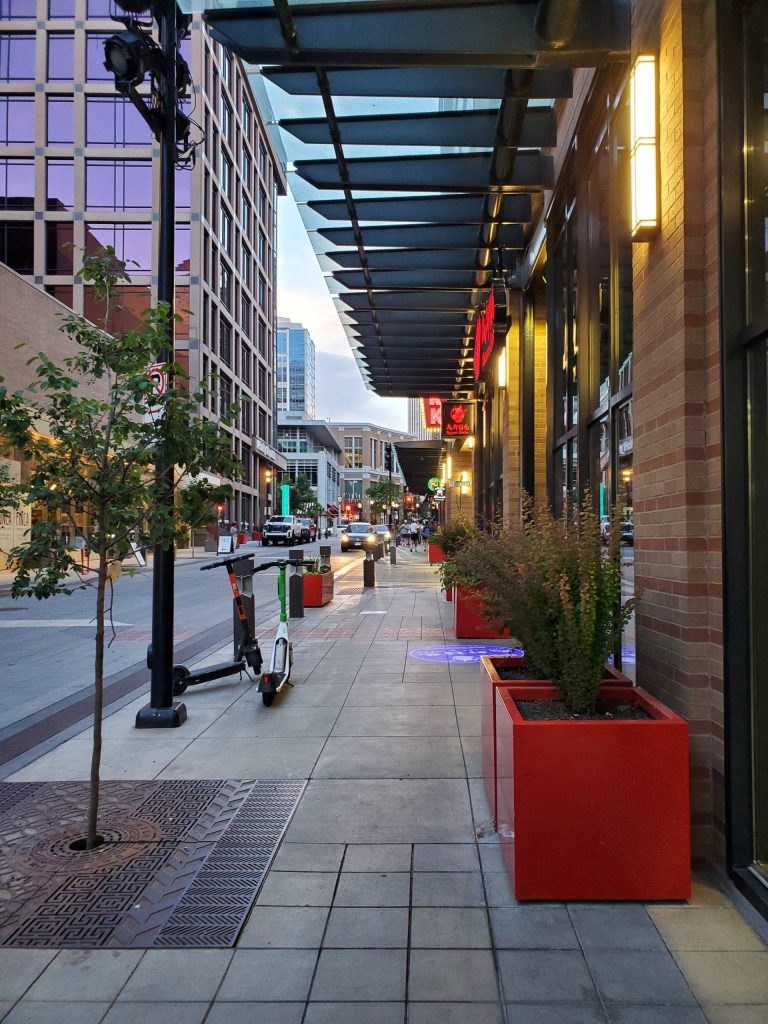
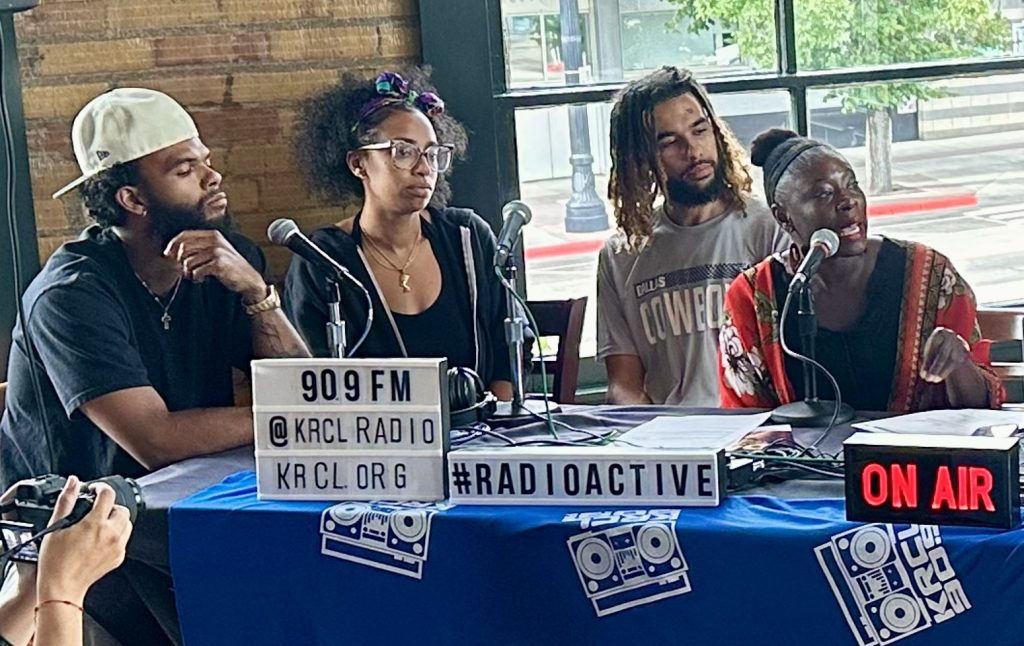
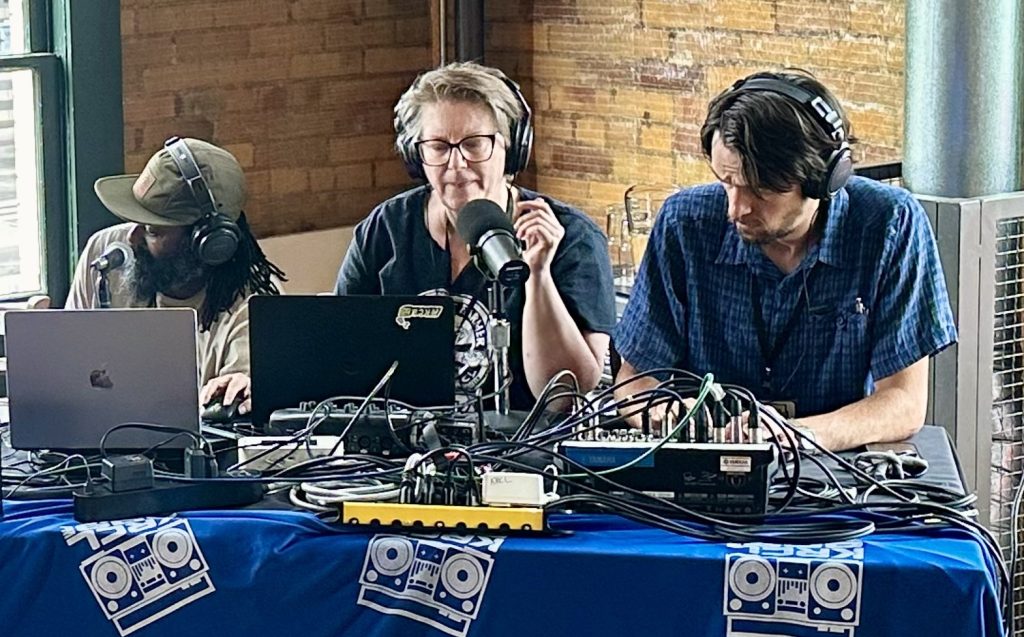
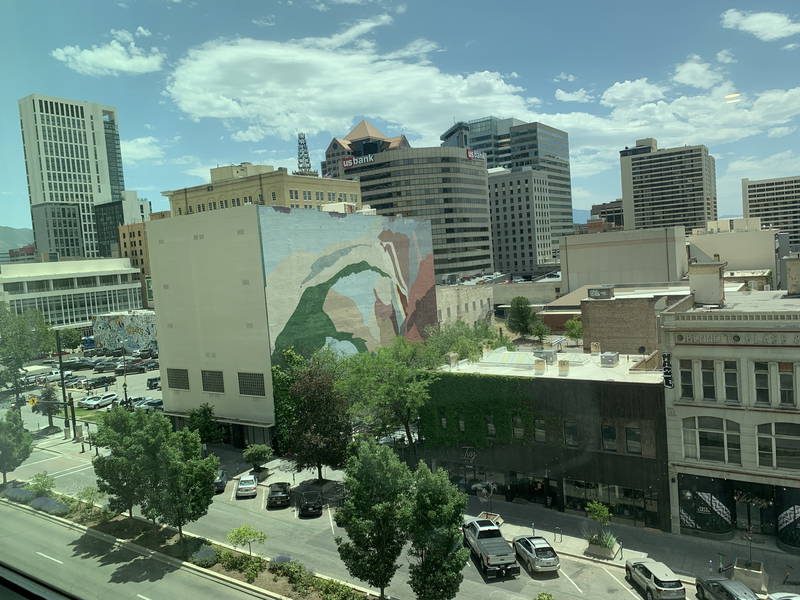
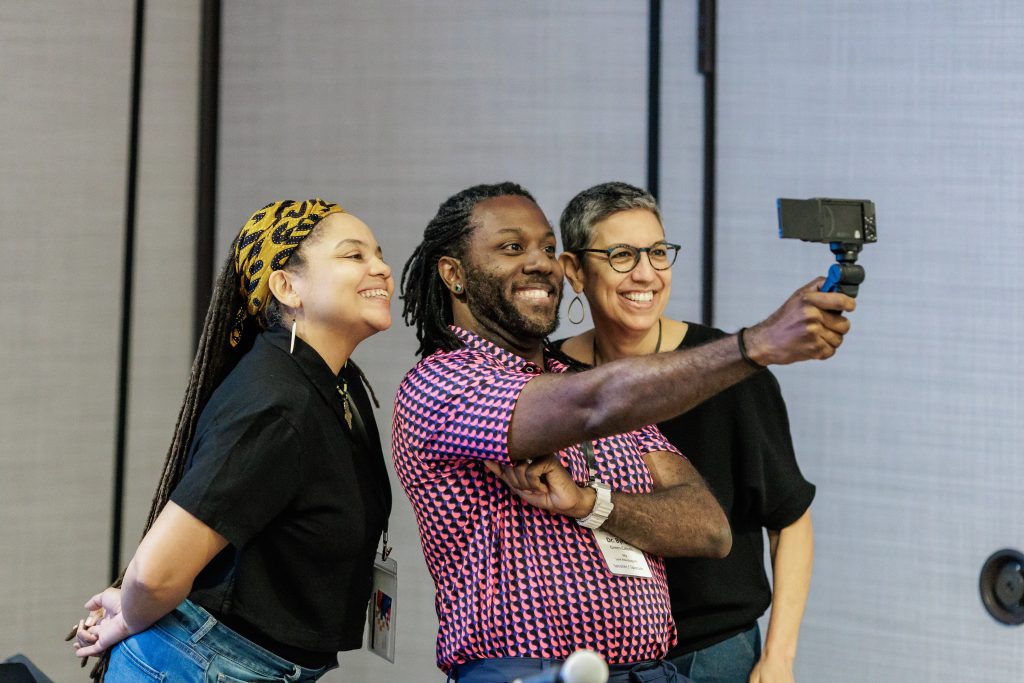

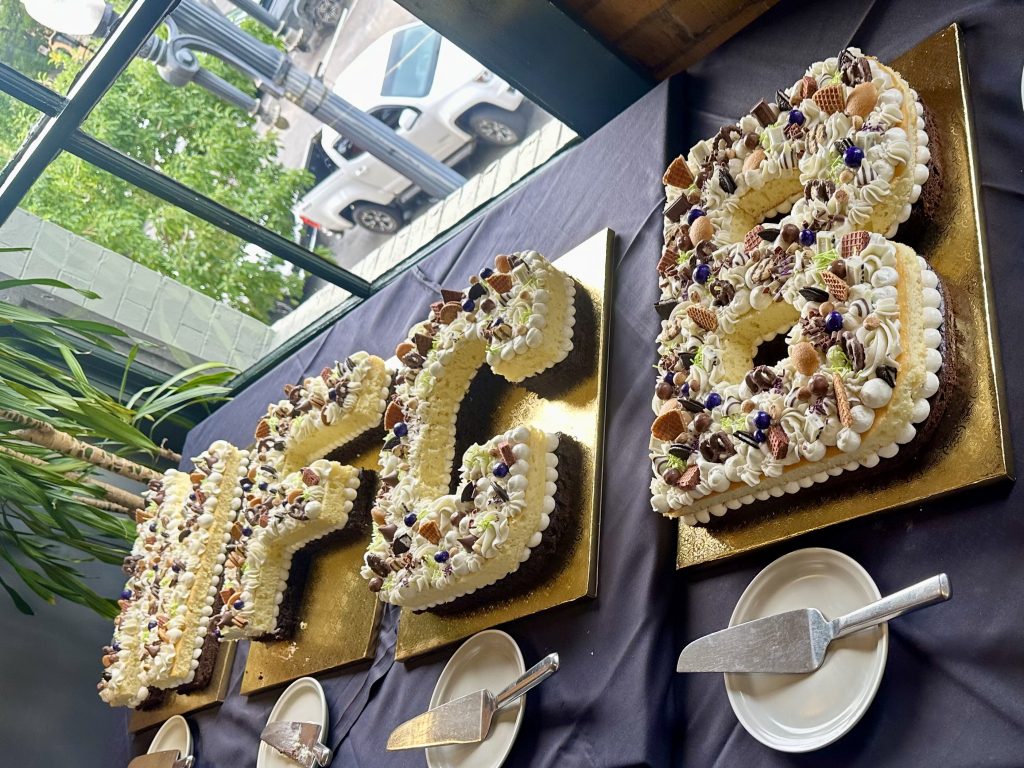
Stephanie: Yes. Radio station people learn to be scrappy!
This thought takes me back to the planning stages that NFCB went through for Salt Lake City. When you all were creating the anniversary conference, were those the touchstones that you launched from–underwriting, volunteer culture, programming, and working with the board? Or what was your approach?
Serah: Well, we had a lot of conversations leading up to this conference about ‘What should the overall theme be?’ because in the past, NFCB conferences have had a theme, you know, like “resilience”, or, you know, “strengthening community”. So, in late summer 2024 we landed on “centering joy.” We were always going to have that as a theme, you know, because it’s our 50th. But then January happened, and the election, and it became more about meeting immediate needs, which was really challenging, because when you’re trying to plan a conference that’s 8 to 10 months away, and this is sort of like how the sausage is getting made. You’re trying to line up speakers and topics and make things relevant. It’s almost impossible, because you’re like, ‘Well, we don’t even know if there will be a public media in June, and we’re talking about it in December, right?’
So, there were definitely, well, I’m getting a little bit ahead of myself. One of the things that was really important to us in 2024 [was] we conducted a Member Services survey, which NFCB does every couple of years, just to do a kind of a blanket, ‘who’s in the room?’ You know, we ask demographic questions that are kind of simple. ‘Are you classified as a rural or an urban station? Do you know your broadcast reach? Do you know roughly the population of your broadcast area? What’s your budget?’ And then we ask questions about programming style, how NFCB membership is most used, growth edges as a station, and where support is most needed. And I used those results to basically get like, ‘Okay, these are the top five topics that people need help with.’ Roughly in order they were fundraising and revenue generation, then technology in engineering for radio operations, which included everything from automation, compliance, to digital content. There was some talk about sound exchange and streaming. Then the third one was community engagement and volunteer management, which feel like two very different things, but they’re kind of in the similar realm of engagement, and then programming and content development, which can include training for volunteers as well, because part of that is engagement and management. But when you’re thinking about developing content or developing programming, there is also that part of like, ‘How are you engaging your talent?’ And then the fifth one was board development and governance. So I used those five main responses to guide what we talk about. And unsurprisingly almost all of them already kind of fit into how we already have organized our tracks in the past, like we’ve used the NFCB’s circle of engagement to think about those four buckets, right? There’s the content, the engagement, the revenue and organizational capacity. So those were our four tracks, and the needs of the stations fit into that in good ways.
Stephanie: So you had a structure that was there already, and then you could just elaborate on it.
Serah: Yeah. Thankfully, it felt like it worked this year. And we did design the conference workshops to be able to spend more time on some of the bigger topics that maybe can’t be cookie cuttered into the regular programming track. Like I was so excited to be able to bring Becky Meiers and David Klann into the room to talk about the air chain. I called it demystifying your air chain because, as a former GM and a person who wore all the other hats like part time, like hack engineer, I would have loved to have had somebody give me three hours of their time and just say, ‘Here’s how It works, from the microphone to the tower to the radio,’ because we don’t always get to make time for that at our stations. So, yeah, it was kind of intuition, listening to people and hearing what their needs were. The only thing I’ll say about that is the survey kind of closed in the fall of 2024 and so then people’s needs didn’t necessarily change, but there were more emergent needs that started to become clear as the conference got closer. Understanding Data was one theme that we touched on under navigating uncertainty.
Stephanie: Like Analytics?
Serah: Analytics. And then also there was all this; in the last six months, there’s been a lot of talk about the researching unmet needs survey and the public radio tech survey that the Jacob brothers (Jacobs Media) survey. So we wanted to be able to provide some hard numbers that stations could use to help with their fundraising and their engagement because sometimes it can feel really nebulous. You’ll be like, ‘Yeah, we broadcast to 100 square miles, but we have no idea who listens. So what can we say?’ And so our thought was like, ‘Well, here’s four different groups that are doing data gathering and analysis, and we can create an NFCB member station overlay, and that way you can have some hard and fast information to be able to use.’ FCC compliance was a big one because of Brendan Carr’s investigations into underwriting.
Stephanie: Right. Brendan Carr is the current Chairman of the FCC that’s supposedly “cracking down” on underwriting. He is creating some fear. And everyone’s talking to lawyers and trying to figure out what is true.
Serah: Yeah. And there’s a lot of, I don’t want to call it misinformation or disinformation, because those words are so heavy, you know, they’re loaded. But there’s a lot of understandably, like, fear based preventative belief systems that I think can get perpetuated, that are absolutely founded and make sense for some stations. And we put together a panel that was a little wild and wooly, but with Sharon Maeda, who, you know, was part of the origin story of Pacifica and Gavin Dahl at KRCL and Ken Freedman at WFMU, to talk about some of those, what we call the mythical rules, like we’re trying to keep it playful, but you know, the idea was to kind of fight fear and to myth bust some of these mythical rules that really do sincerely come out of good intention and risk management and just trying to keep the thing on the air, you know? And we were trying to validate that, and also say, you know, ‘If you’re in the position to rethink some things or branch out, or do the thing you’ve been wanting to do, but you’re not sure if you’re allowed, like, here’s what to know.’ So that was a response to one of the more emergent and pressing issues.
Stephanie: Is there an example that stood out from that session?
Serah: Well, one which is interesting has come up recently, which was the myth that if you air any kind of political content, that you could lose state or federal funding. And so the myth bust moment which Ken Freedman brought up was like, ‘that’s not true, and there’s been no documented case of this.’ And actually let me see I can find [the presentation slide]. Okay, right here. So he says,
“The myth is that airing material that takes one political side or another, even satirically, will endanger your station’s federal or state funding.” And then the fact came up that this has never happened, and there’s no FCC or IRS rule banning the broadcast of opinion or satire.
For the session I had made a little sign that said, “not a lawyer,” because none of us on the panel, or me as a moderator, were lawyers, and all of this information was presented from our experience and our self education.
And what’s interesting is that we had somebody reach out to us afterwards that said, “Well, Minnesota Public Radio actually just lost some state funding because they were criticized for being too left leaning.” But okay, when I followed up with this person, he messaged me privately to say, “Well, actually, that was a behind closed doors conversation.” So the real official reason for taking back funding was because the grantor or the state didn’t approve of how that money was being spent, the amount that they were giving the CEO of Minnesota Public Radio, I think, and something about the 990 I don’t know the details. But then in conversation, this person had heard that also their programming is way too left leaning. So again, it’s one of those things where I can’t provide guidance to almost 200 community radio stations based on an off the record, behind closed doors conversation like, that’s irresponsible, and yet, this is what we’re starting to see more and more of. So there is still this push and pull about fighting fear and paranoia and managing risk. And for some stations, they need to manage risk, and so I’m going to opt for the safest route possible. That’s what they do, and that makes sense, and that’s manageable for them. And there are other stations with much more capacity, with a lawyer on retainer and a very educated staff, and they say, “No way we know the rules. We’re going to go right up to the edge of that envelope because we know what we’re doing, and we’ve got the resources to handle it.”
Stephanie: That’s refreshing to hear. What we’ve been doing at Pacifica Network is cautioning people to take the least amount of risk, because most Pacifica affiliates don’t have lawyers. But stations who do, it’s refreshing to hear people who say, “Yeah, go get on your horse, because we’re standing up for this.”
Serah: I don’t really have the sense of how many stations are doing that knowingly. You know, the vast majority of the stations are like, “Oh no, I just don’t want to be in the spotlight. I’m just trying to check all my stuff in the background. Keep things kosher.” And if they decide that they need to create a House policy that’s like, ‘You know what? These days, let’s just not talk politics on the air. Guys, just leave that to the music. Let’s not editorialize,’ even though interestingly, it’s totally legal.
Stephanie: It’s the idea of wanting to follow the law, but not wanting to succumb to a chilling effect, to end up self-censoring because of fear.
Serah: Unless you’re knowingly doing that. We started to see that happen in conversations on our listserv. That sort of chilling effect started with intense censorship of underwriting copy, and really like fine tooth combing semantics within underwriting copy, which is a legitimate reaction to a threat of the FCC investigating NPR stations, right? But then when that starts to go into, ‘What about what a DJ can say when it’s not an underwriting thing?’ Well, what if the DJ wants to make a comment about blah, blah, blah, and that’s when we started to know. Just like, ‘You know, I think it would be a good idea to just have a blunt conversation about this, with, like you said, with the very clear and welcoming and loving recognition that ‘You gotta do what you got to do,’ and there’s no judgment. But I want people to feel informed so they don’t feel like they’re trapped in this little censored bubble they’re choosing for safety reasons and for their own mental health, to choose not to talk about politics this season.
Stephanie: Having everyone think it through.
Serah: Really, ‘What’s the point of our station right now? What are we doing here? And does this actually make sense to put this kind of stuff on the air? Let’s think about this.’
Stephanie: I understand the rule on opinions is the guest can say whatever they want, basically, in terms of political content. It’s just the host that has to be careful.
Serah: Yeah, and that’s how I’ve understood it pretty much my entire career. And then in the last year or so, somebody shared something with me that was like, ‘No, actually, the host can say whatever they want.’ Like the DJ can endorse a candidate, can tell people to go out and vote for so and so and but then, since then, I’ve heard other people say the opposite, like, say more of what you’re saying. Like the host should just be neutral, and the guest can say whatever they want. So that’s still something that I’m like, I feel like I’ve never actually seen a black and white version of what is actually allowed, so it totally makes sense that there’s confusion and fear.
Stephanie: Right
Serah: There’s also this thing that’s like, if you’re on the air, you represent the station, so a station cannot endorse or oppose, right? So does that mean anybody who is in charge of the microphone? But then also, are those like antiquated rules? Because nobody, no volunteer DJ is getting their broadcast certification anymore? So, this is a big gap in my knowledge, and this is where I lean on our legal counsel. And I pop up my ‘I’m not a lawyer’ sign.
Stephanie: I appreciate you speaking about that. Changing gears, what was something that was particularly fun about hosting the conference for you?
Serah: Oh, there’s so much that was fun about it. From a planning side, I was really excited about the things that fell outside of the norm. So, making space for people to socialize and chat. We decided to do our vendors and exhibitors in a corral type setting, but in a much bigger room where people had a lot of reasons to go and visit. So they had their beverage breaks and their snacks there. But that’s also where the merch table was, and there were tables with power strips to socialize and take your little meetings or whatever you had to do, and the scavenger hunt game that helped people solve a little riddle and also visit everybody and get to take home some conference swag. And we did– this is where my grassroots nonprofit is showing– I made this like six foot long, hand drawn 50 year timeline for people to put their little additions on, or their big additions on, like, you know, especially for the younger broadcasters, like a lot of them were born in the last 50 years. So if they’re a general manager, and they were born after 1975 that should go on the map. So those were things that were supplementary to the tracks (conference sessions), and things that would help people feel like they had a sense of belonging. You know, I really wanted it to feel fun in any way that it possibly could. Inside of a hotel with no windows. I was like, ‘How can we bring the fun?’
Stephanie: I think it worked. We enjoyed being one of the vendor tables in that room. It became a central hub of just hanging out and made it really easy to talk to people.
Serah: Good, yeah. Every time I peeked in there, I was like, This is great. It doesn’t seem like people are avoiding the vendors because they don’t want to feel like they’re being sold something, right? But I felt like everyone was happy to chat with anybody, regardless.
Stephanie: It really created that kind of climate, because some people would want to talk, and they really wanted to network. And some people just wanted to scan the thing for the treasure hunt. And that was fun. Just like, ‘Oh, you’re on the quest for the swag socks. Cool.’
Serah: I think that was part of what was really fun. I come from a design background, so I was personally having fun thinking about how the whole conference flowed as an attendee experience, like being able to flow from one thing to the next, and sort of what the overall, feeling was from spending time with peers at breakfast, and then being able to be inspired by a keynote speaker that was very thoughtfully considered and chosen for this time, and then to move out into your breakout sessions and trying to plan, like, ‘What’s the vibe of breakouts that I want to have in the morning versus the evening,’ and that’s kind of nerdy, but I enjoyed that part of it.
Stephanie: Because it was created that way, it helped me realize that it was most important for me to connect with others as people whether or not they were interested in our vendor table. And that was just always a great place to start. It didn’t matter where it went. And yeah, I really liked connecting that way.
Serah: That’s great to hear. Yeah. Just like, ‘I want to meet you as a person first.’
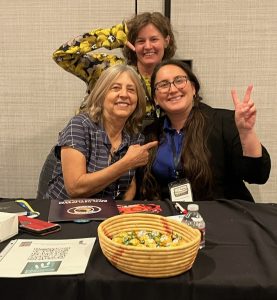
Stephanie: So, what was something that was challenging and creating the conference?
Serah: There were so many things, but the thing that rose to the top that, was kind of an aha moment for me when planning this, because we all took key roles in planning this, especially me and Gretchen Aston-Puckett, but this was my first conference for NFCB that I had been tasked with programming, like who and what are the things that we’re offering. And Gretchen is so incredible and handled hotel logistics, vendor logistics, meal logistics, and registration,
Stephanie: The food was amazing. It was a King’s Bounty every day. (laughing) but I interrupted…
Serah: I know, I was like, wow, this is excellent. So, the biggest challenge, slash, “aha moment,” for me, was that NFCB, you know, like, Pacifica, right? We’re a membership organization. You could almost say, like a trade organization in some ways, right? But we don’t have a specific area of focus for our support. So we support those five things that I mentioned earlier, like some media organizations, where their conferences might be focused on marketing and development. I’ve never been to a GRC (Grassroots Radio Conference) yet, which is wild, but I understand that they have a wide scope of what they talk about and and also it has a focus on LPFM, so they have a niche in terms of the size of station that they might be supporting, but I feel like we’re similar to them in that we are trying to create really, really useful programming (presentations) that is/are covering every single thing that is being a radio station. So, whether it’s in the nonprofit world about engagement and board dynamics and governance, leadership training, or it’s in the like super radio realm of like, talking specifically about underwriting, or talking specifically about training your on-air hosts, or how your air chain works, or understanding how to analyze the data from your radio station stream, right? So, it’s so broad, and within our membership, we had stations who are LPFM, stations that just barely became members, right, all the way up to stations who have been members for so long they’re part of the organization’s story, and they’re very well established. They have a much larger budget, and they have many paid staff, right? So not only is it the breadth of topics, but it’s also the spectrum of like, capacity and operations. So that was really hard. And I think in some sessions I hit the mark perfectly, and other sessions totally missed the mark. You know, like, it’s hard to have only four tracks at a time, which, to be honest, at times, feels like too much to have happening all at the same time. Yeah, and in the room, you’ve got somebody who’s never heard of underwriting, and somebody who’s been doing development for 20 years. How do you task one amazing person with creating a one hour session that’s going to answer everything?
Stephanie: Right, someone who can meet everyone where they are.
Serah: So, like, descriptions are key and I tried my best to offer in any way that I could something that would fall along the spectrum for almost every topic, so whether it’s music departments 101, to a one hour session about psychographic data—I was just trying so that everybody felt like, ‘Well, at least there was one thing or two things that really, really spoke to me.’ And then a bunch of things in the middle, you know?
Stephanie: It sounds like a healthy way to approach it, so that everyone can find at least one or two that they can really connect with.

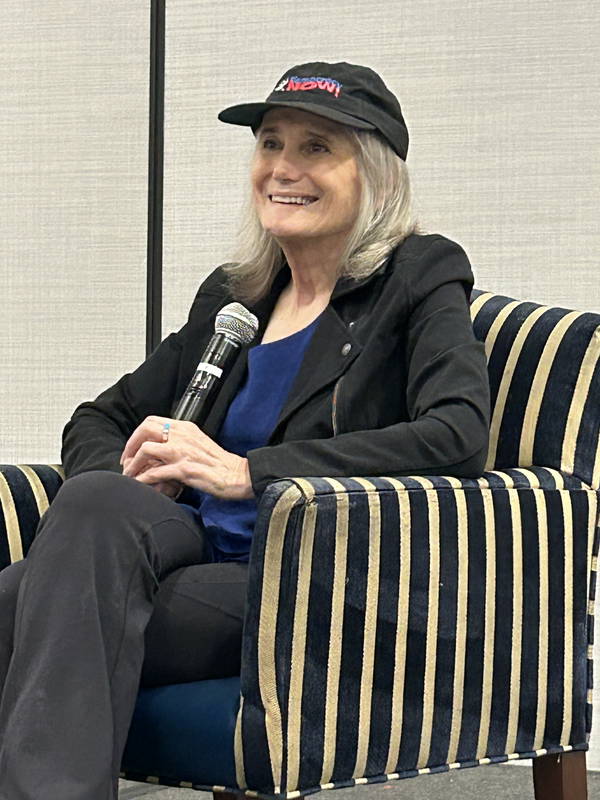
Serah: And then, if there’s one or two that they can really connect with, plus the keynotes and the plenaries and the after parties and stuff, and then, and of course, someone called it the hallway track, which I love. So, I think, ‘this is worth it for that person, it’s worth the money and the time that they invested to come here.’ And for me, with my first conference, I felt like ‘I don’t know anything, so I’m going to go into every session and feel like I’m the newbie.’ And what I really learned was, ‘Oh, KZMU is actually doing a lot of stuff really great. So even though I knew what they were talking about, and in some cases, I felt like I could add to it. I’m still really glad that I went, because I had no idea where my station stood, and now I do. So hopefully, others feel like that too.
Stephanie: When you were saying that you wanted to bring joy, and you all also wanted to respond to current events with resilience, It brings to mind the keynote speakers you had, Vu Le and Amy Goodman, a staunch representative for each quality. Were there any takes they had that you resonated with?
Serah: You know, I had this funny realization, as a planner of the event. There’s so many times where I had one ear on what’s happening, and then the rest of my body was somewhere else, like, thinking about somebody to ring the bell at five till (for the next session) and I had to make sure that there were vegan options at the food table. And I gotta, you know, right? But for me, there were a lot of things that stood out from each of their talks individually, like The Gramsci Gap.
Stephanie: Oh yes, Vu Le referred to The Gramsci Gap as a time between the old world and the new, where the old world is ending and the new world is trying to be born. He said the Gramsci Gap is the time in between, which is a time of monsters…
Serah: And this, for me, a big picture thinker, a spiritual person, relates to the year of the snake and shedding the skin. And this idea of renewal. And even though both of those descriptors were kind of graphic and dark in a way, they left me with a feeling of hopefulness. I knew this about Vu. I’ve been a fan of Vu for years and years, and I knew that he would be the perfect person for this crowd, because he talks about nonprofit work in such an incredible way that I relate as a nonprofit sector worker and as a radio person. And like a grassroots radio person he often makes jokes about the three week old, partially eaten hummus that’s in the communal fridge. And I know that, like 50% of our member stations at this moment have that happening in their communal fridge right now, and having someone talk about that, it’s just this incredible sense of community and hilarity and allowing us to not take ourselves so seriously, which I think is such a hard thing that we’re all guilty of sometimes. Because we’re doing this work, it’s really important work, we have to take it seriously. But those two examples really stood out to me. I also think his ability to take really hard subject matter, like our relationships with our donors, and just kind of put it out there in some really frank terms, in a way that I think validates some of the frustration that we all have, but then also gives everyone an opportunity to rethink it. So Vu, I think, doesn’t dwell on all of the things that aren’t working, like he’s very responsible about that. He says, here’s all the things that aren’t working, here’s what’s hilarious about them, and here’s how we can do it differently, and it’s going to be hard, and maybe not everybody can do it, or at least not tomorrow. But, you know, here’s a path. So it’s not like we’re walking into a cave. It’s like we’re walking into a tunnel where there’s something else over there on the other side. And I think that he really excelled in that way.
And with Amy, she hit like probably 700 points.
Stephanie: Yes she addressed all groups who have contributed to community radio, and how diversity makes a community great.
Serah: Yeah, yeah. I think what struck me about her talk is actually what happened in the very beginning. It reminded me of, like, when you’re in high school, and your high school brings in a motivational speaker, and they kind of walk around the room, and they start to bring people in and connect everybody in these little ways. And she was talking, she was naming individual radio stations from her work in the past and her connection to them. But it was in this way that started to build bridges across radio stations in the room, so before she even got into her talk, I felt like, wow, we all just had a crash course in how all of our stations are connected. And even if a station has a completely new staff from the time when Amy first interacted with them for some story decades ago, they’re still part of this greater timeline and its greater fabric that is community radio. So it wasn’t even a specific story that she was giving. It was just kind of her quick highlight reel of how we’re all together in this room, yeah. And I thought that was….
Stephanie: Really just a powerful gift in itself
Serah: Yeah, exactly.
Stepanie: So, wow. We covered so much.
Do you have any thoughts about how NFCB’s mission has evolved over the years? I know that you’re relatively new, so you don’t have the whole purview, but I thought I would ask.
Serah: You know, that is another inspiring question. As you know, this conference was our kickoff to our 50th year. And so over the next 12 months, we’re hoping to bring other forms of celebration to the membership. We’re going to have a video screening in the fall. One of our board members, JC Polk, is a producer, and does work with video production. He’s working on a piece that can compile photographs and ephemera and a look back. That also means I’m looking back at like, again, as a graphic designer, like all of our old logos over the years, which haven’t there haven’t been too many, but it has been interesting to see. But I think if there was a way to actually find the actual mission statement over the years and how those may have changed from when I first onboarded with NFCB–I spent a lot of time closely with the amazing Sally Kane, to get a sense of where we are. ‘Where is/ what is NFCB now, and what has it been?’ And she gave me this very wonderful nutshell story of how NFCB started, in a time when a lot of stations were getting their licenses and figuring things out, and NFCB was kind of like a hub for ‘Here’s how to do it right, here’s how to do it legally. So you’re not all starting from scratch.’ So it felt scrappy. It was a need. And there were a lot of stations that were getting started around the same time that also needed that information, and then it grew intensely, and was focusing on, I can’t remember how the time frame breaks down, but there was a certain decade where the need was really more about advocacy on a federal level. So NFCB was doing a lot more of the advocacy work, which is still part of our mission statement. And then there was a time where it was more about training about certain nonprofity things, like governance and strategic planning and theories of change and budgeting, so you can kind of track how NFCB has served member stations over the years–the growth cycle of a radio station. And NFCB has been able to be really nimble to meet those needs as they’ve changed. So while I can’t say with any confidence, like, if the actual mission statement has changed, I know that part of our value is being able to be nimble and give customized support. Like, for the last couple of years, we did the Community Counts Initiative, and it was about helping stations build capacity to do really amazing programming that serves their community, develop a strategic plan. And it was kind of like, I don’t want to say a boot camp, because that’s so militaristic, but it was intensive, yeah, to get their core functions in a really healthy place, from organizational capacity to programming to engagement and all that. And now I feel like, for stations in the membership the emergent need is like, ‘We’re in the oh shit moment of like, how do we talk about how important this is, so that people will continue to donate while they face all this uncertainty. How do I lead my team when nobody knows if we’re going to have a job in six months? Or how do I keep my team members safe if I have staff of color, trans staff or queer staff, you know, how do I, or immigrant staff?’ You know? Yeah. So there’s these emergent safety questions. The one thing I was going to add to that with the public safety, Public Radio Legal Handbook and the Underwriting Guide, the practical guide that we have. I think it was in the 20-teens NFCB worked with NPR through a grant from CPB to create the safety manual, which is the SAFER which stands for Station Action for Emergency Readiness. And so that’s like another kind of tome that we were able to create to offer our member station. So they’ve got the facts on the legal side of things. They’ve got kind of a definitive guide for underwriting, and they’ve got a somewhat definitive guide for emergency preparedness. All of those things have changed since they were originally written. So like now, what we’re focusing on is adding attachments and new articles to address underwriting things. We’re currently trying to figure out how to update the Public Radio Legal Handbook and translate it to Spanish. And then we’re also working with a partner on updating the emergency preparedness manual, even though it’s not very old. It has references to, like, using Twitter, things like that, so, and then ideally, being able to translate that as well.
Stephanie: That’s great. Wow. I feel like I’ve learned so much. Do you have anything else you would like to add?
Serah: I would just say, you know, this conference happened at such a wild time in the timeline of like, the importance of public media to our communities across the country. So there were moments that definitely felt kind of bittersweet. You know, like for me personally, it felt like a major achievement. And at the same time, because there’s so much uncertainty and because we’re all waiting for this Senate vote [on the Big Bill], it’s frustrating. I feel like there’s a little bit of this cloud hanging over us like, yes, we have to celebrate the fact that we all came together. And it can be a heavy lift for stations to send one or two people across the country for three days. It’s a big deal, and I recognize that, and I’m humbled by it, and I want it to just stand alone as beautiful and empowering and motivating. And I’m kind of annoyed that on the heels of that, I’m like, ‘How should we prepare, messaging to our member stations if and when something happens?’ We’re just so in the thick of the things that it’s a really bizarre time. I don’t feel like I’m floating on the success of the conference, instead of just like, ‘Hey, right back to the thing.’
Stephanie: Well, you know, you guys made the conference into an oasis of camaraderie, and that means a lot.
Serah: Oh, thank you for saying that. I was so I’m so happy that you all came.
Stephanie: We are happy we came too! Thank you for taking the time to speak with me today.
Serah: Thank you
